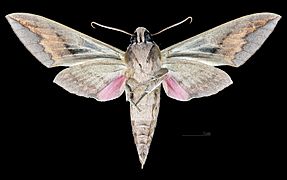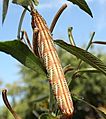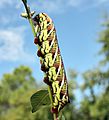Banded sphinx facts for kids
Quick facts for kids Banded sphinx moth |
|
|---|---|
 |
|
| Scientific classification | |
| Genus: |
Eumorpha
|
| Species: |
fasciatus
|
| Synonyms | |
|
|
The Banded Sphinx Moth (scientific name: Eumorpha fasciatus) is a type of moth. It belongs to a family of moths called Sphingidae. A scientist named Johann Heinrich Sulzer first described this moth in 1776.
Contents
Where Do They Live?
The Banded Sphinx Moth lives in many places. You can find it in South America. This includes countries like Argentina, Brazil, and Colombia.
It also lives in Central America. This area includes Mexico, Guatemala, and Panama. In North America, you can find them in the southern parts of the United States. They live in states like California, Texas, and Florida. Sometimes, they fly north to places like Michigan or New York. They are also found in the Caribbean islands.
What Do They Look Like?
The Banded Sphinx Moth gets its name from the bands on its body. Adult moths have a unique look. They are often a mix of brown, pink, and yellow colors. Their wings help them blend in with their surroundings.
Their Life Story
Adult Moths
Adult Banded Sphinx Moths are active all year in warm, tropical areas. In cooler northern places, they usually have two main flying periods. One is from late May to July. The second is from late August to October.
Adult moths like to drink nectar from flowers. Nectar is a sweet liquid that gives them energy. They have been seen feeding on flowers like Crinum, Catharanthus roseus, and Petunia.
Moth Larvae
The young moths are called larvae or caterpillars. They eat leaves from different plants. Some of their favorite plants include Ludwigia species. These are often called water primroses. They also eat Cissus verticillata and Magnolia virginiana.
The caterpillars can look very different from each other. They come in many colors and patterns. Some are green, some are pink, and some are even black. This helps them hide from animals that might want to eat them.
Becoming a Pupa
When a caterpillar is ready to change into a moth, it becomes a pupa. This stage happens underground. The caterpillar digs a burrow in the soil. Inside this burrow, it transforms into a pupa. The pupa then changes into an adult moth.
Different Types
There are two main types, or subspecies, of the Banded Sphinx Moth:
- Eumorpha fasciatus fasciatus
- Eumorpha fasciatus tupaci (This type is found in the Galápagos Islands.)
Gallery

















